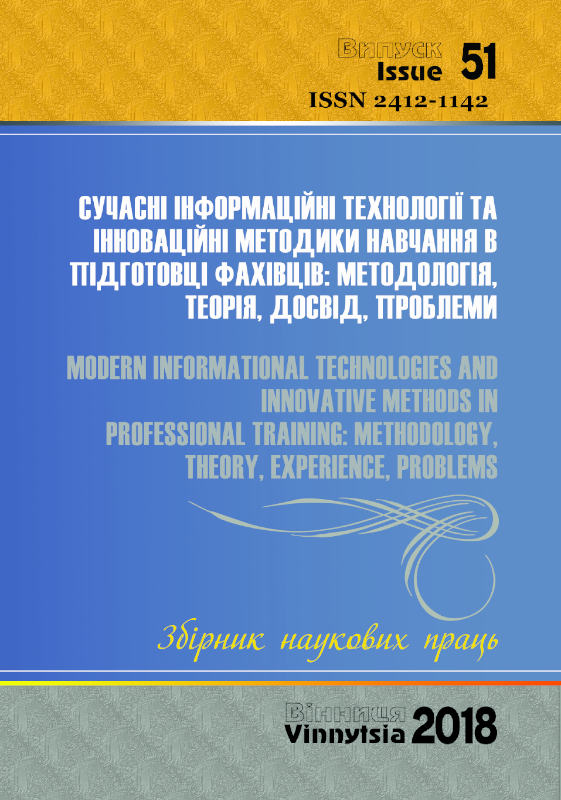DIDACTIC POTENTIAL OF THE NARRATIVE METHOD IN THE MODERN HIGHER SCHOOL
Keywords:
narrative, narrative method, multimodal narrative, interpersonal interaction, communicative skills, self-knowledge, reflection, learning process, higher educationAbstract
The article is devoted to the theoretical analysis of the structural and functional characteristics of
the narrative as one of the main methodological concepts of contemporary socio-liberal knowledge. The narrative
method as an educational and methodological factor that contributes to the process of creating and producing
sociocultural meanings of the life of each student is studied. The narrative is a logical story)of interaction with people
who constantly carry out moral and ethical choices, and with the world at large. Narrative performs the function of
constructing a personal way of life in certain sociocultural conditions. It involves not just presentating students’
thoughts about a particular event, activity, etc., but embraces the transfer of students’attitudes to what they describe.
It is noted that reflection becomes an inalienable attribute of the narrative as a sociocultural tool, which provides
students with a deeper self-understanding, and complements the communicative component of education by updating
cultural, values meanings of their life. The narrative is considered from the pedagogical standpoint, which actualizes
the transformation of knowledge into a direct productive base for (self) cognition and stimulation of self-realization of students. Understanding sociocultural and personal experience and its embodiment in the narrative serves as the basis
for building students’ own life strategies and their implementation in various spheres of their lives. The features of the
narrative method as a means of education, which internalizes values and acquired experience into the life world of a
personality, are highlighted.
Downloads
References
Лещенко М. Методи біографічних досліджень в дискурсі освітніх наративних практик / Наукові записки
Київського національного університету імені Тараса Шевченка. – Київ. – 2012. – No 2. – С. 62–65.
Рікер П. Інтелектуальна автобіографія. Любов i справедливість / П. Рікер ; пер. iз фр. B. Шовкун, В. Каденко,
С. Желдак. – К. : «Дух i літера», 2002. – 114 с.
Тимчук Л. І. Цифрові наративи в навчанні майбутніх магістрів освіти: історія, реалії, перспективи розвитку :
монографія / за наук. ред. Лещенко М. П. / Лариса Іванівна Тимчук. – К. : САММІТ–КНИГА, 2016. – 390 с.
Bal M. Narratology: Introduction to the Theory of Narrative / Mieke Bal. – Toronto : University of Toronto Press,
– 256
Bruner J. Two Modes of Thought, Actual Minds, Possible Worlds / Jerome S. Bruner. – London : Harvard University
Press, 1986. – 201 с.
Bruner J. Self-making and world-making / Jerome S. Bruner // Journal of Aesthetic Education. – 1991. – Vol. 25. –
No 1. – P. 67–78.
Bruner J. The Culture of Education / Jerome S. Bruner. – Harvard University Press, 1996. – 224 p.
Cushman E. New Media Scholaship and Teaching : Challenging the Hierarchy of Signs / Ellen Cushman //
Pedagogy. – 2011. – Vol. 11. – No 1. –P. 63–79.
Dieterle B. Digital First-Year Composition: Integrating Multimodality into Writing about Writing Approach / B.
Dieterle & S. Vie // Journal of Global Literacies, Technologies, and Emerging Pedagogies. – 2015. – Vol. 3. – No 1. –
Р. 276–289.
Gergen K. J. Narrative, Moral Identity and Historical Consciousness: a Social Constructionist Account [Electronic
resource] / Kenneth J. Gergen // Erzahlung, moralische Identiat und historisches Bewusstsein. Eine
sozialkonstructionistische Darstelung. – 1998. – Mode of access:
Labov W. Narrative analysis: Oral versions of personal experience / W. Labov, J. Waletzky // Essays on the Verbal
and Visual Arts: Proceedings of the American Ethnological Society [Helm J. (Ed.)]. – Seattle : University of
Washington Press, 1966. – P. 12–44.
Lauer C. Contending with Terms “Multimodal” and ”Multimedia” in the Academic and Public Sphere / Claire
Lauer // Computers and Composition. – 2009. – Vol. 26. – No 1. – Р. 225–239.
Polkinghorne D. P. Narrative Knowing and the Human Sciences / Donald P. Polkinghorne. – Albany : State
University of New York Press, 1988. – 248 p.
Prince G. Narratology: The form and function of narrative / Gerald Prince. Berlin : Mouton,1982. – 184 p.
Rosenwald G. C. Conclusion : Reflections on Narrative Self-Understanding / George C. Rosenwald // Storied lives:
The cultural politics of self-understanding [George C. Rosenwald & Richard L. Ochberg (Ed.)]. – New Haven, CT :
Yale University Press, 1992. – Р. 265–289.
Sax P. Re-Authoring Teaching: Creating a Collaboratory / Peggy Sax. – Rotterdam,Taipei : Sense Publishers, 2008. – 312 c.
Selfe C. Multimodal Composition: Resources for Teachers / Cynthia Selfe. – Cresskill, NJ : Hampton, 2007.
– 270 р.
Williams B. T. Heroes, Rebels, and Victims: Student Identities in Literacy Narratives [Electronic resource] /
Bronwyn T. Williams //Journal of Adolescent & Adult Literacy. – Dec., 2003–Jan., 2004. – Vol. 47. – No 4. – Р. 342–
– Mode of access : http://mjreiff.com/uploads/2/9/1/7/2917319/bronwynwilliams.pdf.
Woolhouse C. Multimodal life history narrative: Embodied identity, discursive transitions and uncomfortable
silences / Clare. Woolhouse // Narrative Inquiry. –2017. – Vol. 27. – No 1. – Р. 109–131.
Trzebinski J. Narracyjne konstruovanie rzeczywistosci / J. Trzebinski // Narracja jako sposob rosumienia swiata. –
Gdansk : Gdanskie Wydawnictwo Psycologiczne, 2002. – S. 17–43.
Downloads
Published
Issue
Section
License
Copyright (c) 2018 С. Федоренко

This work is licensed under a Creative Commons Attribution 4.0 International License.

